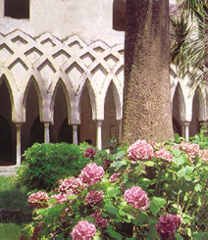








 |
 Dedicated
to St. Andrew, Amalfi cathedral rises at the end of steep steps and dominates
the square of the same name. In the middle of the square is the
eighteenth-century fountain of St.Andrew or of the People. The original plan of
the building dating back to the ninth century was redone in 1203 on a Sicilian
Arab-Norman shape and then restructured over the centuries. The particularly
beautiful fašade, rebuilt after its collapse in 1861, has remarkable mosaic
decoration in the tympanum, portraying Christ enthroned between the symbols of
the Evangelists and the terrestrial podesta, designed by Domenico Morelli. To
the left of the fašade rises the bell tower, begun in 1180 and finished in
1276, and although restored many times, has kept its original appearance. In
1389 it was used as a defensive tower against the attacking Angevins, it is
composed of one floor with double-light and another with triple-light windows,
architectural elements clearly of Norman derivation, culminating in an Arabian
inspired multicoloured majolica-tiled dome. The bronze doors are imposing, cast
in Constantinople before 1066, with relief figures of Christ, Our Lady and
Saints Andrew and Peter. The interior of the church, with three naves and on a
Latin cross, rebuilt in Baroque style, contains frescoes, statues and other
notable works of art: the paintings of Andrea d'Asti, that adorn the ceiling of
the central nave and the transept, the Renaissance marble altarpiece with three
saints, the sixteenth-century tomb of Bishop Andrea d'Acunto and two ambones
with mosaic decorations belonging to the original church. The 1253 crypt that
houses a huge statue, the gift of Philip III of Spain, and a reliquary, both of
St. Andrew, is worth visiting; as is the Crucifix Chapel that preserves
thirteenth-century elements. Dedicated
to St. Andrew, Amalfi cathedral rises at the end of steep steps and dominates
the square of the same name. In the middle of the square is the
eighteenth-century fountain of St.Andrew or of the People. The original plan of
the building dating back to the ninth century was redone in 1203 on a Sicilian
Arab-Norman shape and then restructured over the centuries. The particularly
beautiful fašade, rebuilt after its collapse in 1861, has remarkable mosaic
decoration in the tympanum, portraying Christ enthroned between the symbols of
the Evangelists and the terrestrial podesta, designed by Domenico Morelli. To
the left of the fašade rises the bell tower, begun in 1180 and finished in
1276, and although restored many times, has kept its original appearance. In
1389 it was used as a defensive tower against the attacking Angevins, it is
composed of one floor with double-light and another with triple-light windows,
architectural elements clearly of Norman derivation, culminating in an Arabian
inspired multicoloured majolica-tiled dome. The bronze doors are imposing, cast
in Constantinople before 1066, with relief figures of Christ, Our Lady and
Saints Andrew and Peter. The interior of the church, with three naves and on a
Latin cross, rebuilt in Baroque style, contains frescoes, statues and other
notable works of art: the paintings of Andrea d'Asti, that adorn the ceiling of
the central nave and the transept, the Renaissance marble altarpiece with three
saints, the sixteenth-century tomb of Bishop Andrea d'Acunto and two ambones
with mosaic decorations belonging to the original church. The 1253 crypt that
houses a huge statue, the gift of Philip III of Spain, and a reliquary, both of
St. Andrew, is worth visiting; as is the Crucifix Chapel that preserves
thirteenth-century elements.
 From
the atrium of Amalfi Cathedral access is gained to the enchanting Paradise
Cloister (Chiostro del Paradiso), one of the most famous and interesting
buildings in the small town. Built in 1266-68 on the orders of archbishop
Filippo Augustariccio as a cemetery for illustrious and worthy citizens, the
Cloister is a delightful building in Arabian style made up of a peristyle of
coupled columns, that support interlaced pointed arches, enclosing a lovely
small garden with palm trees. Abandoned at the beginning of the seventeenth
century, the Cloister was restored in 1908; in the galleries important remains
from the Roman and medieval periods can be admired: two ancient columns
supporting eagles, the sarcophagus of the decurion P. Ottavio Rufo, two Roman
sarcophagi with bas-reliefs, one portraying the wedding of Peleus and Tethys,
the other the rape of Proserpine, a fourteenth-century sarcophagus and, finally,
fragments of the Cathedral's ancient facade From
the atrium of Amalfi Cathedral access is gained to the enchanting Paradise
Cloister (Chiostro del Paradiso), one of the most famous and interesting
buildings in the small town. Built in 1266-68 on the orders of archbishop
Filippo Augustariccio as a cemetery for illustrious and worthy citizens, the
Cloister is a delightful building in Arabian style made up of a peristyle of
coupled columns, that support interlaced pointed arches, enclosing a lovely
small garden with palm trees. Abandoned at the beginning of the seventeenth
century, the Cloister was restored in 1908; in the galleries important remains
from the Roman and medieval periods can be admired: two ancient columns
supporting eagles, the sarcophagus of the decurion P. Ottavio Rufo, two Roman
sarcophagi with bas-reliefs, one portraying the wedding of Peleus and Tethys,
the other the rape of Proserpine, a fourteenth-century sarcophagus and, finally,
fragments of the Cathedral's ancient facade
|
